- HubPages»
- Arts and Design»
- Crafts & Handiwork»
- Textiles
Weavers And Weaving - Part I
Weaving is the oldest of the great crafts. Goethe called it, "The nurse of civilization." The elements of weaving are the thread and loom. Nature provides four main fibers:
- Cotton
- Flax
- Silk
- Wool
Cotton was first cultivated in India and in the region of the Andes in South America. Flax from which linen is made, comes from Egypt and northern Europe, where its use has been traced back to the New Stone Age. While, wool has been used from earliest times in warm and cold countries alike.
Unfortunately, it attact certain moths which feed on it, so specimens of early wool fabrics have been found in only a few sites, chiefly in Egypt and Peru where the hot, salty soil has preserved them.
The chief wool bearing animal is the sheep, but very fine threads have also been spun from the wool of certain coats and camels -- such as the goats of Kashmir.
The use of silk, the most marvelous of nature's fibers, was for a long time kept a secret by the Chinese.
In addition to these substances, metal thread has always been a great luxury and one of the weaver's most treasured secrets. It was first made by winding gold or silver wire beaten flat around a core of silk or linen thread; later the pure metal was replaced by narrow strips of a gilded or silvered membrane, gut, or vellum.
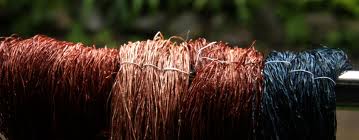
Dyeing The Thread
Before most fibers can be woven on a loom, they must be spun. spinning is the twisting of fibers into one long strand, the thread and winding of this on a kind of long spool, called a spindle.
The thread, even in very early times, was often dyed. A good range of colors could be obtained with natural dyestuffs. These were mostly extracted from plants:
- Blue from woad and indigo
- Red from madder
- Yellow from saffron
- More brilliant hues of red were derived from the dried bodies of insects -- kermes and cochineal.
- Purple, most coveted of colors in the ancient world, was extracted from the glands of certain shellfish. The vivid hue is often referred to as Tyrian purple.
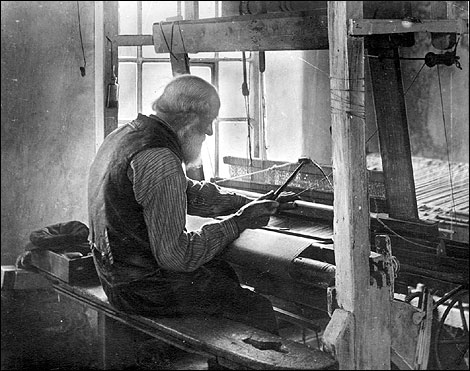
The Loom
The loom is not a single invention but the result of a long and steady series of mechanical improvements going on over more than two thousand years.
The basic part of the loom is a beam to which a number of threads are fastened side by side. These are called the warp. Another thread or threads form the weft.
In the primitive hand looms, the warp threads were kept stretched by tying to each a weight, perhaps a pebble or a bead of clay, or by fastening them to a second beam. In the most primitive weave, the weft thread was carried across the warp threads, over and under. To the second beam a belt was attached, which the weaver fastened around the waist as they sat or crouched in front of the loom.
By leaning slightly forward the weaver lessened the tension on the threads. By leaning back a little they could increase the tension.
Thus, the weaver became a part of the loom. By this type of weaving, the wonderful fabrics of old Peru were produced. Even today, you can occasionally see this type of weaving being done on such looms by native peoples in Latin America.
In other parts of the world, the warp beams were connected with a frame. Thus, the finished weave could be pulled up over one beam while extra long warp threads were released from the other.
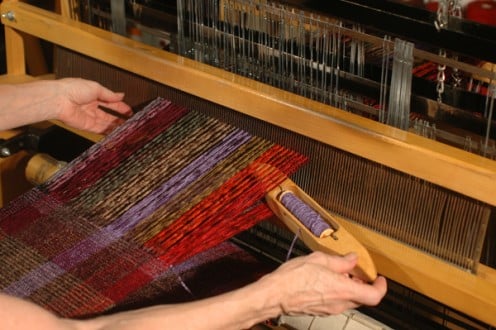
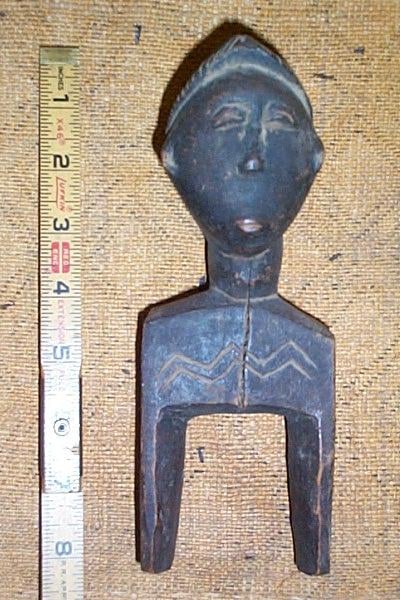
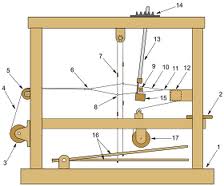
The Shuttle, Heddle, And Other Improvements
The next invention was probably the shuttle. This is a spool, or bobbin around which the weft thread is wound, then covered with a rigid case shaped like a little boat.
A shuttle can be pushed smoothly in and out among the warp threads.
The heddle is a device for raising certain warp threads so that the shuttle can make its way in and out still more easily. Many heddles are used in weaving patterns in a fabric.
A big improvement came when the heddles were connected with threadles (levers worked by the foot). Now the weaver could use both hands for throwing the shuttle.
This type of loom is generally called a hand loom, but the pedals are already an important step toward a mechanical loom.
The hand loom is still found in all parts of the world. It is much used in third world hospitals for occupational therapy, which means "healing through work." It's one way of keeping hands and minds pleasantly occupied.
Types Of Woven Fabrics
There are three fundamental types of woven fabrics:
- Cloth
- Satin
- Twill
Today, in a disposable world, most people don't do any darning (repairing) of clothing, such as socks. However, back when they did they would have used a simple weave which consisted of a weft thread being carried across the warp threads, over one, under the next, over, under, over and so on to the last warp, and back again, reversing.
The simple crossing of weft and warp, over and under, has been used for a very long period indeed, and even today the word "cloth" is used for any woven fabric.
Satin is a fabric of many fine warp threads that seem to lie entirely on the surface. The weft threads pass over them in irregular spacing and disappear completely. The smooth, glossy surface makes satin the ideal weave for silk thread. It was probably first used in China, the principal silk land.
Satin can be simple or it can have patterns of a contrasting weave, cloth, or twill. In damask silk, the weave is reversed. What is satin on one side is cloth or twill on the other.
Twill requires the use of at least four heddles. The first weft is passed under one warp, then over a group of warps, generally from three to five, then under one, and so on.
On the return and in all following throws of the shuttle, the one uncovered warp is moved obliquely, one thread to left or right. Thus, diagonal lines appear on the woven fabric. The simple twill can be changed to herringbone twill, a zigzag effect produced by alternating the direction of the twill. The results resembles the backbone of a herring.
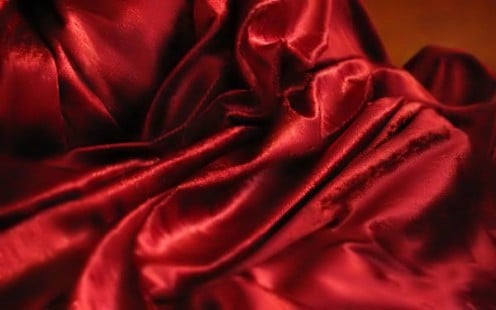
All of these weaves can be used as the foundation of velvet, by running an extra warp thread over a series of small rods, thus raising this thread over the basic fabric. When the rods are pulled out, small loops remain. This is uncut velvet.
If a knife is run along a grove in the rod, slitting the tops of the loops, we have cut velvet or cut pile. The combination of cut and uncut loops in one pattern is called cisele velvet, from the French word for metal-carving.
All of these fabrics, velvet included, may be further enriched by a kind of embroidery, by brocading, worked out during the process of weaving. This is done by introducing additional weft threads only where they are needed to make the pattern. They do not run from selvage to selvage (edge to edge). This, much costly thread is saved and the fabric is not unnecessarily heavy.
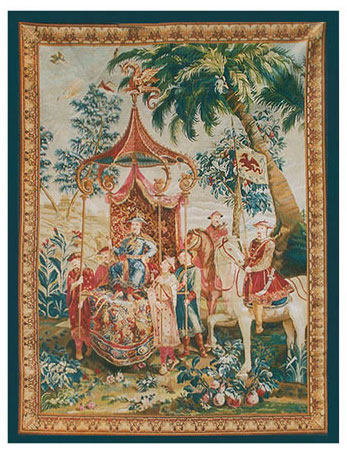
Tapestries -- Patterns and Color In a Simple Cloth Weave
Fabrics that have elaborate patterns and, often, many colors are woven on what is known as a Jacquard loom. The earliest pattern weaving on simple looms was done by the tapestry technique.
Tapestry is a simple cloth weave, but the wefts do not run across the entire width of the fabric. The weaver uses a number of bobbins, one for each color. Each bobbin is passed through the warp only as far as its color is required by the design, and is then turned back.
If two color areas meet in a vertical line, a slit occurs. These slits can be avoided by the designed of the pattern.
Or the weaver dovetails the adjoining colors, or interlocks the wefts of two colors at their meeting point.
Sometimes, as in the Asian Kilim (a special kind of flat rug) and in many tapestry woven fabrics of Peru, the slits are left open as part of the pattern.
In the great pictorial tapestries that have been woven in many European countries from the Middle Ages to this day, the slits are simply sewed together on the back of the fabric.
For tapestry weaving, the weft threads are much heavier than the warps, which they cover completely. In the earliest tapestries, the warp is generally of linen; the wefts are woolen.
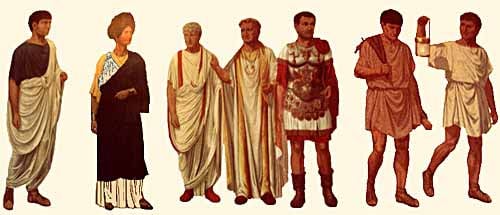
Scenic Borders Of Tapestry Woven In The Garments Of Ancient Romans
The dress fashion of the Roman Empire, in the early centuries of the Christian Era, demanded elaborate ornament around the neck and sleeves and long bands over the shoulders.
Round or square motifs are interwoven below these bands and near the hemline. Such tapestries have been preserved in large numbers in the hot, dry soil of Egypt, which was, as you know, once part of the Roman Empire.
There the dead were buried in their everyday clothes and wrapped in shrouds which often had been hangings or curtains. There is a wide variety of designs; some look like adaptations of floor mosaics, others like wall or book paintings.
There are plants, wild and tame animals, birds and fishes. There are scenes from Greek and Roman mythology and even from the Bible. The story of Joseph, the sacrifice of Isaac, the birth of Christ and His Ascension; portraits of saints, and crosses woven as if hung around the neck -- were all very popular. Most delightful are scenes of shepherds and their flocks.
If You'd Like To Know More!
- Ancient Roman Clothing
Informations about Roman Clothing - Ancient Ruins Tapestries And All Tapestry Wall Hangings Along With Accessories Like Tapestry Rods
Ancient Ruins Tapestries along with all kind of tapestry wall hangings, tapestries rods available here. Buy cheap Belgian Tapestries, Flanders Tapestries, European Tapestry, Bayeux Tapestries, Royal Tapestries etc. - Clothing Styles Of Ancient Romans
- Usage Of Ancient Tapestries |
General large trades were used to weave carpets. Many types of fibers were used as the gold lace, silk and son Silver weaving multiple images of subjects with - Usage Of Ancient Tapestries |
General large trades were used to weave carpets. Many types of fibers were used as the gold lace, silk and son Silver weaving multiple images of subjects with








